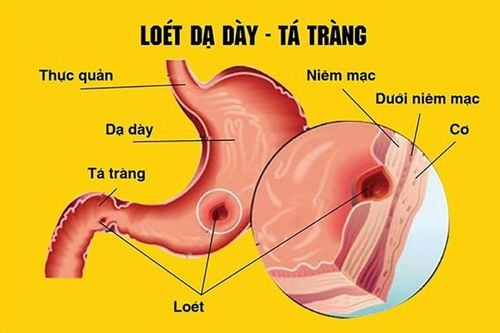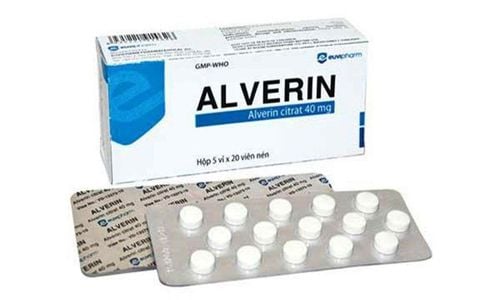This is an automatically translated article.
In gastroesophageal reflux disease in children, immature lower esophageal sphincter function is manifested by frequent transient dilation of the lower esophagus, leading to the appearance of retrograde gastric contents. into the esophagus.
1. What is gastroesophageal reflux disease in children?
Gastroesophageal reflux in infants is characterized by the backflow of stomach contents into the esophagus. It is a normal physiological process that can happen several times a day. Between 20 and 30% of babies have reflux more than 3 times per day during the first few months of life.
Fortunately, most cases of gastroesophageal reflux in children are benign and will resolve on their own as the child gets older. Most infants with regurgitation do not require specialized examination and treatment.
2. Causes of gastroesophageal reflux in children
Reflux after meals occurs in healthy people. Several hypotheses have been proposed that the small gastric capacity of infants leads to gastroesophageal reflux. However, the true causes and risk factors for GERD in children are often a combination of factors.
The anatomical factors that predispose children to gastroesophageal reflux disease include:
The angle formed by the esophagus and the axis of the stomach is obtuse angle in the neonate. This angle decreases as the child grows, ensuring a more effective barrier against GERD. The presence of a diaphragmatic hernia can move the lower esophageal sphincter into the thoracic cavity, where lower intrathoracic pressure can facilitate gastroesophageal reflux. However, the presence of a hernia mass by itself does not predict gastroesophageal reflux, which means that many children with diaphragmatic hernias do not have gastroesophageal reflux. When a child has gastroparesis, gastric outlet obstruction and pyloric stenosis can impede gastric outflow and increase pressure in the stomach leading to regurgitation and vomiting. Other factors that predispose children to GERD include:
Drugs, eg diazepam, theophylline, methylxanthines that aggravate reflux secondary to decreased sphincter tone Exposure to tobacco smoke Alcohol Poor eating habits, such as children overeating, eating late at night, lying on their backs immediately after eating Food allergies Certain greasy, highly acidic foods Gastrointestinal disorders slow emptying time stomach Transient lower esophageal sphincteric spasm Obesity Neurodevelopmental defects, such as children with cerebral palsy, Down syndrome, and other genetic syndromes associated with developmental delay are at increased risk for GERD. High esophagitis Liquid diet reduces viscosity and increases gastric volume.

Một số loại thuốc có thể gây trào ngược dạ dày thực quản ở trẻ em
3. What are the symptoms of children with gastroesophageal reflux disease?
The symptoms of gastroesophageal reflux in children are often directly related to the consequences of regurgitation such as poor weight gain ....
Children with gastroesophageal reflux often cry, confused sleep disturbances and decreased appetite. Other common signs and symptoms in infants and young children with GERD include:
Crying, or irritability, Shortness of breath, Slow heartbeat, loss of appetite, Weight loss or poor growth Vomiting Wheezing Abdominal or chest pain Recurrent pneumonia Sore throat, hoarseness or laryngitis Chronic cough. Signs and symptoms of GERD in older children typically include all of the above with heartburn and a history of vomiting, regurgitation, tooth decay, and halitosis.
4. How to diagnose and treat gastroesophageal reflux in children?
Most cases of gastroesophageal reflux in children are diagnosed based on clinical presentation. From there, therapeutic measures can be initiated empirically. However, if presentation is atypical or if response to treatment is minimal, further evaluation with supportive tools such as manometry, esophagoscopy or esophagography, and electrophysiological studies is necessary. .
The goal of therapy for children with GERD is to reduce acid secretion and, in many cases, to reduce gastric emptying time.
Non-pharmacological therapies can be started early in infancy, starting from infancy:
Break up feedings in young children or offer small foods thickened with cereals for older children more Keep the child upright for a period of time after feeding Elevating the head of the bed For older children, additional measures should be applied as follows:
Diet, avoid foods containing tomatoes and citrus, fruit juices, mints, chocolate and caffeinated drinks Eat small meals Follow a relatively low-fat diet as fat slows stomach emptying Maintain a healthy routine Healthy eating habits, daily routine Losing weight Avoid direct and indirect contact with alcohol and tobacco Medicines used for children with gastroesophageal reflux disease:
Medicines to neutralize stomach acid (eg. eg: aluminum or magnesium hydroxide) H2-histamine antagonists (eg, nizatidine, cimetidine, ranitidine, famotidine) Proton pump inhibitors (eg, lansoprazole, omeprazole, esomeprazole, dexla nsoprazole, rabeprazole sodium, pantoprazole).

Chia nhỏ bữa ăn giúp hạn chế trào ngược dạ dày thực quản ở trẻ em
If the above measures have little therapeutic effect, the only intervention indication is the continuous feeding of the stomach through the nasogastric tube. This is an alternative to surgery.
Gastroesophageal reflux in children is a common disorder. Because the causes are quite diverse, ranging from anatomical and functional abnormalities along with extrinsic stimuli, diagnosis and treatment are still challenging. Although the symptoms in this pathology are not specific from infancy to adolescence, if gastroesophageal reflux in children is not detected and corrected early, eating habits as well as developmental children will be affected.
Therefore, as soon as the child has gastroesophageal reflux disease for a long time but applying conventional treatment methods (such as changing lifestyle, eating, living,...) is not effective, Parents should take the child to a reputable medical facility for appropriate examination, diagnosis and treatment.
Currently, the Pediatrics Department at Vinmec International General Hospital is trusted by many parents to examine the diseases that infants and young children are susceptible to. Vinmec brings satisfaction to customers and is highly appreciated by industry experts by:
Gathering a team of leading pediatricians: including leading experts with high professional qualifications ( professor, associate professor, doctorate, master), experienced, worked at major hospitals such as Bach Mai, 108... The doctors are well-trained, professional, conscientious - understanding and understanding young psychology. In addition to domestic pediatric specialists, the Department of Pediatrics also has the participation of foreign experts (Japan, Singapore, Australia, USA) who are always pioneers in applying the latest and most effective treatment regimens. . Comprehensive services: In the field of Pediatrics, Vinmec provides a series of continuous medical examination and treatment services from Newborn to Pediatric and Vaccine,... according to international standards to help parents take care of their baby's health from birth to childhood. Advanced techniques: Vinmec has successfully deployed many specialized techniques to make the treatment of difficult diseases in Pediatrics more effective: neurosurgery - skull surgery, stem cell transplantation blood in cancer treatment. Professional care: In addition to understanding children's psychology, Vinmec also pays special attention to the children's play space, helping them to play comfortably and get used to the hospital's environment, cooperate in treatment, improve the efficiency of medical treatment. References: emedicine.medscape.com, journals.lww.com, hopkinsmedicine.org, nuh.com.sg













